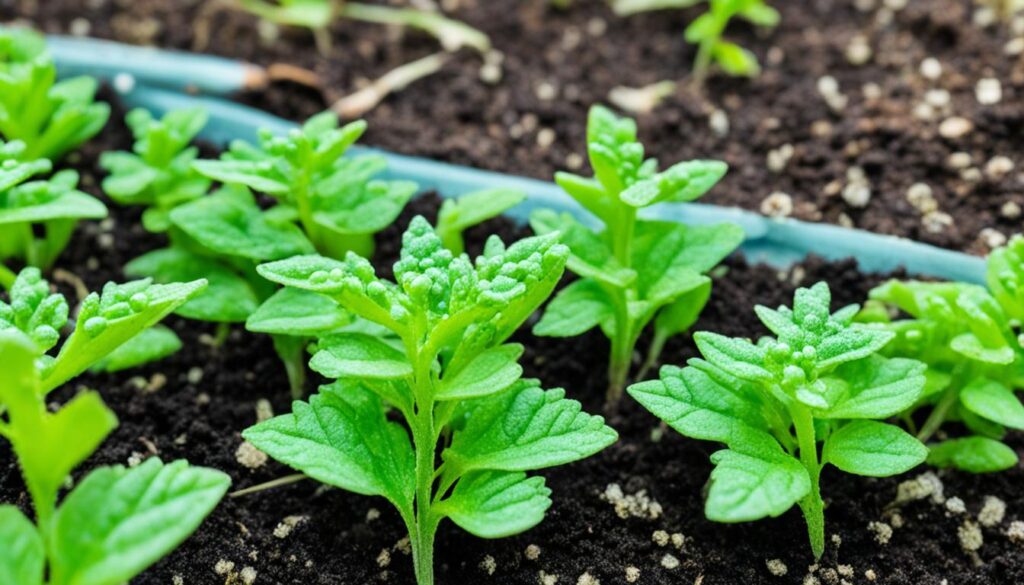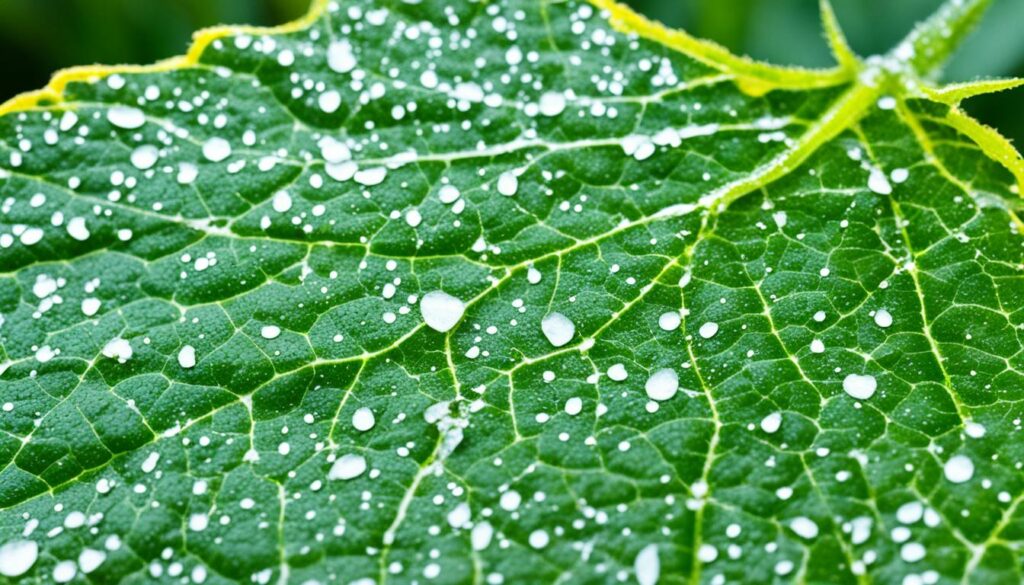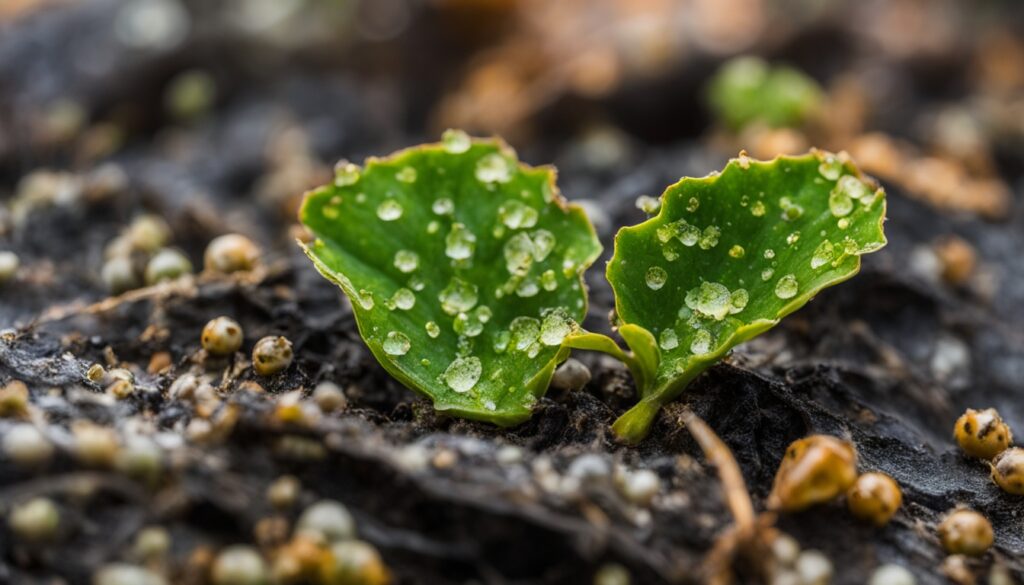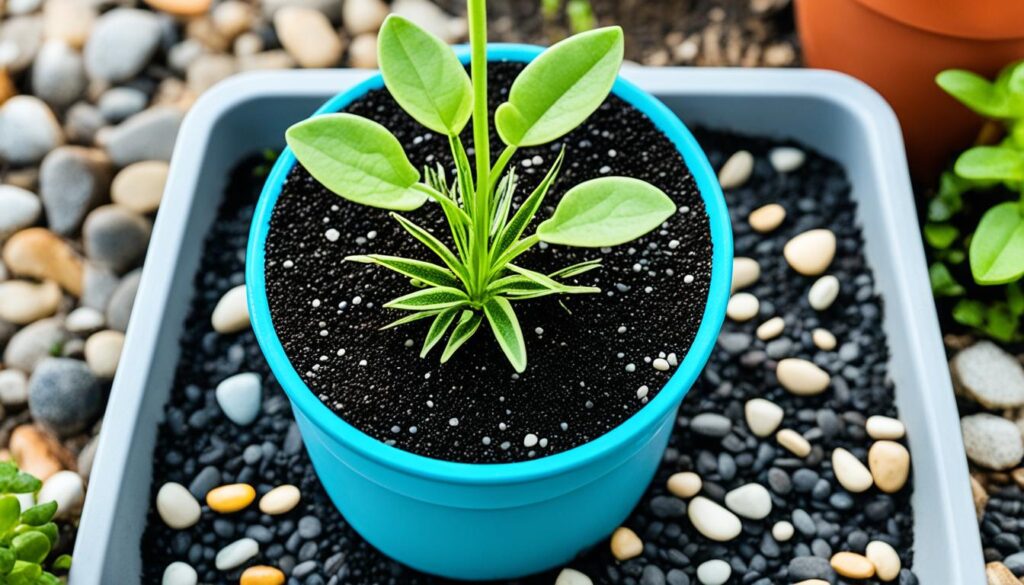There’s a peaceful feeling in a garden’s gentle hum, like nature’s own symphony. I feel a deep connection with the earth when I touch the soil. But, our gardens also attract unwanted guests – garden bugs. These tiny pests can quickly damage our plants, leaving them looking sad.
Every year, I face the challenge of keeping these pests away using eco-friendly solutions. In organic gardening, knowing which pests to watch out for is key. This knowledge helps me use pest control methods that are safe for the garden and the environment.
Even tiny pests like spider mites, which are only a millimeter long, need careful attention1. Broad mites prefer warm and humid places, making them harder to control1. To fight them, I use Natural Plant Wash on every leaf and stem1. Russet mites also pose a threat, causing plants to turn bronze1. But, there’s always a natural way to fight them, using plant wash and isopropyl alcohol1.
As the seasons change, so does the gardening challenges. In fall, we can enjoy cooler weather crops and a new gardening rhythm. Whether it’s hot or cold, our goal remains the same – to keep our gardens healthy and balanced.
Now, let’s explore the common garden pests and how to keep them in check. We’ll find out how to maintain a healthy balance in our gardens.
Key Takeaways
- Identify garden bugs early and utilize targeted eco-friendly solutions.
- Spider mites, broad mites, and russet mites demand different organic pest control approaches based on their unique behaviors and preferences1.
- Employ a combination of Natural Plant Wash and isopropyl alcohol for severe pest infestations1.
- Maintain a clean garden to discourage pest habitats and protect the ecosystem.
- As the seasons change, adapt gardening practices and embrace the growth of fall vegetables for a diverse and resilient garden.
- Understanding and managing garden pests supports sustainable and successful organic gardening efforts.
Understanding the Miniature World: An Introduction to Garden Bugs
Welcome to the world of garden bugs, where learning about insects helps us appreciate and care for our gardens. These tiny creatures play a big role in keeping our gardens healthy. They help us use natural remedies and keep the garden balanced.
The Role of Insects in Your Garden Ecosystem
Insects are key to our gardens, doing more than we see. They help with pollination, aerating soil, and breaking down organic matter. Knowing about their roles changes how we garden. For example, some insects eat pests, reducing the need for chemicals.
Spotting the Good vs. the Bad: Beneficial Insects and Garden Pests
Knowing which insects are good or bad is crucial for garden care. Good insects like ladybugs and bees help by pollinating and eating pests. Spotting pests like aphids early can prevent damage to plants.
“Garden Insects of North America” by Whitney Cranshaw is a great guide for gardeners. It has over 3,300 full-color photos to help us identify insects2.
| Insect Type | Role in Garden | Action Suggested |
|---|---|---|
| Bees, Butterflies | Pollination | Encourage by planting diverse floral species |
| Ladybugs | Pest Control | Introduce more into the garden ecosystem |
| Aphids, Caterpillars | Pest | Monitor regularly and use natural remedies |
Keeping a garden is both an art and science. It’s about understanding the roles of different creatures and keeping the ecosystem balanced. With the right strategies and observation, we can use natural remedies to create a healthy garden full of life and beauty.
To truly appreciate our garden, we must explore the world of these tiny creatures. By supporting beneficial insects and managing pests, we improve our garden’s health. We also help the global ecosystem.
Identifying Common Aphid Infestations in Your Green Space
You might not even notice when aphids start taking over your garden. These tiny bugs can quickly spread, making their presence clear to anyone. They’re small, under a quarter-inch, and come in colors like green, black, red, and yellow, often hiding under leaves34. Let’s explore how to spot these pests and keep your garden healthy with organic methods.
Spotting Aphids: Signs and Symptoms
Aphids multiply fast, often overwhelming plants. They feed on sap, causing leaves to look misshapen, grow poorly, and weaken35. They also leave behind honeydew, which brings sooty mold and ants, making things worse for plants35. To find these pests, look for leaves curled, twisted, or turning yellow, signs of their toxic saliva54.
Eco-friendly Aphid Control Strategies
To fight aphids without harming the environment, try a few eco-friendly methods. Spray plants with water to wash aphids away3. Adding catnip, garlic, and chives to your garden can keep aphids away with their strong smells3. Also, having ladybugs, lacewings, and hoverflies around can naturally control aphids54.

For more specific solutions, use neem oil or insecticidal soap on the affected plants. These are tough on aphids but safe for the planet, fitting well with green gardening3. Always test these treatments on a small part of the plant first to avoid damage3. These steps help keep your garden safe from aphids while supporting the environment and organic gardening.
Dealing with aphids is key for your plants and your garden’s health. Spotting them early and using green solutions helps keep your garden lively and healthy all season.
Sneaky Thrips: Detecting and Managing These Inconspicuous Invaders
Welcome to my garden, where beauty meets the challenge of pest control. Today, we explore the world of thrips, tiny but powerful pests. Managing them is key, especially when they sneak into our gardens.
Thrips are experts at hiding. They leave behind silvery speckles on leaves, showing they’re there. For garden lovers, spotting these signs is crucial in fighting thrips. Their small size makes them hard to see and manage6.
I often use insecticidal soap to fight thrips. This method fits well with integrated pest management, aiming to control pests without harming the environment. Regular checks for thrips can stop infestations early and keep your garden balanced7.
Here’s a simple guide to spot thrips damage:
- Look for tiny black excrement specks and white patches on leaves and flowers.
- Noticeable distortion or discoloration of plant parts, signaling severe infestation.
| Sign of Infestation | Recommended Action |
|---|---|
| Silvery Speckles on Leaves | Apply insecticidal soap |
| Black Excrement Specks | Install sticky traps |
| White Patches on Petals | Consider introducing beneficial insects |
Learning about thrips is important, but action is key to a healthy garden. The aim is to manage thrips, not get rid of them completely. This approach keeps your plants and the environment balanced. It’s the heart of integrated pest management, guiding my gardening.
Battle Against Spider Mites: Saving Your Plants from Tiny Predators
Spider mites are tiny pests that can harm your plants, especially in hot and dry places. As someone who loves organic gardening, I’ve seen how these pests can damage plants by piercing their cells8.
Recognizing Spider Mite Damage

Spotting spider mite damage early can save your plants. Look for signs like stippling, webs on leaves, and a dusty look8. These pests like dry conditions, so keeping your plants moist is key. But even careful gardeners might miss them, as they can grow fast8.
Natural and Organic Solutions for Spider Mite Control
Natural pest control is safe for the environment and keeps your garden balanced. A mix of water and liquid soap can kill spider mites, using 16 parts water to 1 part soap8. Neem oil also helps by stopping spider mites from reproducing8.
For big infestations, using predatory mites like Phytoseiulus persimilis works well, but only after seeing spider mites8. These natural methods take time for your garden to recover8.
Indoor plants from nurseries often get spider mites more easily. But plants grown from seeds are usually stronger against these pests9. This makes me prefer seed-started plants in areas with pests, combining pest control with plant care.
The fight against spider mites in organic gardens is about more than just getting rid of them. It’s about making a garden that can fight pests on its own. Using natural sprays, helping beneficial insects, or picking tough plants all help keep your garden spider mite-free.
Leaf Miners: Unraveling the Mystery of Serpentine Leaf Patterns
As a devoted gardener, seeing leaf miners create serpentine patterns on your plants can be both interesting and worrying. These tiny larvae, part of the Agromyzidae family, affect many plants. Knowing how they act is key to managing them well. Leaf miners are worldwide, hitting everything from flowers to veggies like spinach and tomatoes10.
Through my gardening, I’ve found that catching them early and using natural ways to fight them is vital for a healthy garden. Leaf miners like yellow, so yellow sticky traps work well to catch them. These traps not only trap adults but also alert you to infestations early10.
For those of us wanting to manage garden bugs in a green way, using natural controls is great. Using natural enemies or parasites to fight leaf miners is good for the planet. It keeps your garden healthy without harsh chemicals10.
| Plant Affected | Possible Solution |
|---|---|
| Tomatoes | Row Covers, Biological Controls |
| Citrus Trees | Sticky Traps, Crop Rotation |
| Spinach | Insecticidal Soap, Natural Predators |
Learning about leaf miners’ life cycles and how they spread helps us understand them better. It’s interesting to know they can have many generations in a season, especially in warm places. This means we need to act early10.
Using methods like crop rotation and row covers helps stop leaf miners and keeps plants healthy. This shows the value of natural remedies in our gardens. By learning about pests like leaf miners, we can better protect our plants and help the environment10.
Scale Insects: Dealing with Garden’s Hidden Armor-clad Pests
Dealing with scale insects is key to keeping garden plants healthy. These pests look like small, stuck-on bumps on stems and leaves. They harm plants by sucking their sap and leaving behind honeydew, which attracts more pests11.
Identifying Scale Insects on Plants
Spotting scale insects early can prevent big problems later. They blend in with the plant, making them hard to see. Look for tiny, hard shells on leaf undersides and stems. Catching them early helps stop them from taking over11.

Integrated Pest Management for Scale Problems
Integrated pest management (IPM) uses many tools to control pests safely. For scale insects, natural predators like ladybugs work well. Eco-friendly options like neem oil or soaps also help. Keeping plants healthy with good care also keeps pests away11.
Using products like Wilson BUG-X OUT or Green Earth Horticultural Oil in IPM plans is smart. It fights pests without harming the environment. IPM aims to keep the garden healthy and pest-free11.
Garden Bugs: A Closer Look at Whiteflies and Their Control
Whiteflies are tiny but tough garden pests that feed on plant sap. They are not actually flies but are more like aphids and mealybugs1213. These small insects grow quickly and can cause big problems if not controlled1412.
Whiteflies can be found on many plants, including veggies and flowers1412. In warm places, they can live and breed all year, making them a constant problem for gardeners14.
- Population Surge: As summer heats up, you’ll see more whiteflies because it’s perfect for them14.
- Damage Signs: Look for signs like pale leaves, wilting, and dead plants if they get out of control12.
- Virus Transmission: Whiteflies can also spread plant viruses, making things worse for your garden1213.
To fight these pests, using safe and green solutions works well. Insecticidal soap and neem oil are good choices because they’re safe for the planet14. Green Earth Insecticidal Soap is a trusted brand for dealing with whiteflies14.
| Eco-Friendly Product | Type | Target Pests |
|---|---|---|
| Green Earth Insecticidal Soap | Soap | Whiteflies, Aphids, Spider Mites |
| Neem Oil Extract | Oil | Whiteflies, Mealybugs, Scale Insects |
Sticky traps can also help control whiteflies, especially for catching them early13. By understanding these pests and using the right treatments, you can manage them better. Whether you choose organic or traditional methods, being persistent and proactive is key to keeping your garden safe.
Earwigs: Understanding the Ecology of These Nocturnal Creatures
Earwigs are common in our gardens, known for their unique looks and behaviors. They are often seen as pests at night, causing worry among gardeners.
Earwig Habitats and Diet in Your Garden
Earwigs hide in dark, damp spots during the day and are active at night15. They like to hide under mulch, fallen branches, or leaves15. These spots are perfect for them because they are cold and damp.
In the U.S., most earwigs are either European (Forficula auricularia) or ring-legged (Euborellia annulipes), found mainly in the South16. They look scary but help the garden by eating other bugs and dead plants. But, they can also eat tender plants and veggies.
DIY Tricks for Earwig Control
You can control earwigs with DIY methods and natural remedies. Use damp newspaper rolls or oil-filled cups as traps16. These traps work because earwigs like dark, wet places16.
Also, put diatomaceous earth around your plants to keep earwigs away without using chemicals16. Keeping your garden clean by removing mulch and leaves also helps16. For big infestations, you might need to use insecticidal soaps or spinosad products16.
Managing earwigs is key to a balanced garden. Using these strategies helps control pests and makes your garden healthier and more lively.
Confronting Cutworms: Protecting Seedlings from Nocturnal Attackers
As a gardener, I’ve often faced the challenge of protecting my young plants from cutworms. These pests, the larvae of moths, can destroy a garden overnight by cutting off seedling stems. It’s crucial to fight cutworms to keep our gardens healthy.
Preventive measures are essential to stop these pests. I start by removing debris from the garden, where cutworm eggs hide. Handpicking them at dusk can reduce their numbers. Using cardboard collars around seedlings also keeps cutworms away.
Using natural abrasives like diatomaceous earth around plants stops cutworms. It also keeps away other pests. Encouraging birds to visit the garden helps control cutworms and other pests too.
For big cutworm problems, we might use chemicals. I sometimes use Wilson BUG-X OUT Insecticide-Miticide with 50% malathion. But we use it carefully to protect the environment17.
| Pest Control Method | Effectiveness |
|---|---|
| Removal of plant debris | High |
| Handpicking | Moderate to High |
| Cardboard collars | High |
| Diatomaceous earth | High |
| Encouraging birds | Moderate |
| Chemical control (Wilson BUG-X OUT) | High when needed |
Using a balanced approach to pest control keeps our plants and gardens healthy. Combining natural methods with chemicals when needed helps our gardens thrive. This makes our gardens a safe haven and a tough place for pests like cutworms.
Fungus Gnats: Addressing the Root of the Problem
As a dedicated gardener, it’s key to know how fungus gnats affect our gardens. These bugs are not just a nuisance; they can harm our plants’ health.
Google searches for “fungus gnats” have gone up a lot since 20201. I’ve spent about $302 on products to fight them1.
Life Cycle of Fungus Gnats and Plant Impact
Fungus gnats have a fast life cycle. Their eggs hatch into larvae in 4-6 days, and these larvae eat plant roots for up to two weeks2. This damage is mainly done by the larvae, so catching them early is key.2
Preventive Measures for Fungus Gnat Infestations
To fight fungus gnats, we need good pest management plans. Using sticky traps catches adult gnats well2. Also, potting mixes with air holes stop fungus gnat larvae from breeding2.
- Removing the top soil layer helps defend against them2
- A 3% hydrogen peroxide solution works well against them2
- For big infestations, a second treatment about 5 days after the first might be needed2

In summary, fungus gnats are a common problem, but we can fight them. By understanding their life cycle and using the right preventive steps, we can keep our gardens healthy. With the right pest management, our plants can flourish.
Mealybugs: Coping with Cottony Cushion Scale Cousins
In my journey with organic gardening, I’ve learned that understanding and tackling pests like mealybugs is crucial for plant health. These pests, covered in a cottony mass, love to live on plant fluids. They can harm a variety of plants, from small indoor plants to big fruit trees. It’s important to use effective pest control.
Managing mealybugs requires a mix of methods. For small infestations, a toothpick or a cotton swab with rubbing alcohol works well. For bigger problems, I use insecticidal soap and horticultural oils like Wilson BUG-X OUT or Green Earth Horticultural Oil. These products protect plants from pests without harming the environment.
It’s important to know that mealybugs are related to the cottony cushion scale, a well-known pest. This connection means they can be fought with similar organic methods. This helps me control infestations in my organic garden.
Mealybugs are often found under leaves and in hidden spots on plants. They like places where they can eat without being disturbed18.
Not all mealybug species react the same way to treatments. Most can be controlled with insecticidal soap. But some might need more treatment or a mix of products to get rid of them.
| Control Method | Effectiveness | Applicability |
|---|---|---|
| Insecticidal Soap | High | Most mealybug species |
| Wilson BUG-X OUT | Medium | Selected species, consult label |
| Green Earth Horticultural Oil | High | Diverse range, including sensitive plants |
Understanding the life cycle and how mealybugs reproduce is key to controlling them. They can go from egg to adult in 1 to 3 months. Quick action can stop them from becoming a long-term problem in my garden18.
Every plant I save from mealybugs shows me the importance of careful pest management. Using the right products and methods helps my garden stay healthy and full of life.
Integrated Pest Management: An Essential Garden Practice
Welcome to a deep dive into Integrated Pest Management (IPM), key to keeping gardens pest-free without harsh chemicals. As a seasoned gardener, I’ve learned IPM supports a balanced ecosystem and cuts down on chemical use.
The Principles of IPM in Home Gardens
IPM means making smart choices in our gardens. It starts by understanding pests and their environment. Most insects are good for our gardens, with only a tiny percent needing control19. Planting marigolds, for example, attracts lady beetles that control pests19.
Watching for insects and mites is crucial. This lets us use the right controls and introduce predators like parasitic wasps19. Also, creating homes for birds and bats helps keep pests away and boosts local wildlife19.
Implementing Cultural, Biological, and Chemical Controls
Cultural methods like crop rotation and picking disease-resistant plants are key to IPM. These, along with strategic planting and keeping the garden clean, keep pests away. Introducing natural predators is a powerful way to control pests without chemicals.
When chemicals are needed, choose them carefully to protect the environment. The Environmental Protection Agency (EPA) advises setting a threshold to decide when to act against pests20.
Hand-picking or using water sprays can quickly reduce pests without harming garden life20. Mulching helps by keeping soil moist and controlling weeds, which pests like20.
There are many resources for gardeners to improve their IPM. Places like the University of California and the University of Maryland offer guides to help19.
For more on choosing plants that work well in your area and help with IPM, check out great garden plants in New York.
Using IPM in gardening is more than controlling pests; it’s about building a healthy ecosystem. Whether fighting aphids or boosting garden health, IPM is key to modern gardening. It protects your plants and the planet.
Natural Remedies: Employing Organic Solutions for Pest Control
I’ve seen a big move towards natural remedies and organic solutions for garden pests. In Arkansas, gardeners celebrated a season without chemical pest control after three years of organic practices21. This shows a trend in the U.S., where over 80% of homes have gardens. More gardeners are using eco-friendly pest control and benefiting from beneficial insects22.
Dealing with pests like aphids and tomato hornworms has taught me a lot. Using handpicked methods helps. Strong plants can fight off pests, which most American gardeners know22. We also have microbial allies like Spinosad and B.T. that target pests safely21.
Neem oil and pyrethrin are natural options that keep pests away and kill them. They work well because they reduce insect appetite and shut down their nervous system quickly21. By using these, I’m helping my garden and joining a community of responsible gardeners. We welcome beneficial insects, not pests22.
FAQ
What are the most common bugs found in gardens?
How do beneficial insects contribute to my garden ecosystem?
How can I naturally control aphid infestations?
What are thrips and how can I manage them in my garden?
How do I identify and eliminate spider mite infestations?
What are leaf miners and are they harmful?
How do I deal with scale insects in my garden?
What eco-friendly solutions are there for whiteflies?
How can I keep earwigs from damaging my plants?
What is the best way to protect my seedlings from cutworms?
How can I prevent fungus gnat problems?
How are mealybugs treated in the garden?
What are the fundamentals of Integrated Pest Management (IPM) in gardening?
Can I use organic solutions for pest control in my garden?
Source Links
- 10 Common Garden Pests and How to Prevent and Control Them
- Garden Insects of North America
- How to Identify and Get Rid of Aphids on Plants
- Aphids in home yards and gardens
- Aphids, in-depth
- What Are The Bugs on My Beavertail cactus? 🐞
- What To Do About Bugs on My Serrano Pepper? 🐛
- The Definitive Guide to Winning the War Against Spider Mites
- Trials of Indoor Gardening pt.1: spider mites, aphids, and thrips oh my…
- How to Identify & Control Leaf Miner Flies: Best insecticide
- 🐛 What Are The Bugs on My Slimleaf Milkweed?
- Whitefly – How to Identify and Get Rid of Whiteflies (8 Ways) – Garden Design
- Whitefly – outdoors
- How to Identify and Get Rid of Whiteflies on Plants
- What’s the Deal With Earwigs? – Green Pest Services | Pest Control | Exterminator
- Battling Earwigs in the Garden
- Blog Archives
- Mealybug factsheet.pub
- Practice Integrated Pest Management (IPM)
- Integrated Pest Management for the Garden
- Organic Garden Pest Control
- Organic Pest Control for the Garden


